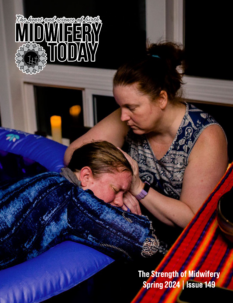
Choosing Caesarean Section
Editor’s note: This article first appeared in Midwifery Today, Issue 57, Spring 2001.
Subscribe to Midwifery Today Magazine
Reprinted by permission of the author from The Lancet, 356:1677–80, November 11, 2000. “Choosing caesarean section”, M. Wagner, published in The Lancet 2000, volume 356, pages 1677–80.
“With a scheduled caesarean section, you and your doctor have agreed to a time at which you will enter the hospital in a fairly calm and leisurely fashion, and he or she will extract your baby through a small slit at the top of your pubic hair. There are a lot of reasons to schedule a caesarean section—other women elect to have a caesarean because they want to maintain the vaginal tone of a teenager, and their doctors find a medical explanation that will suit the insurance company.”—V. Iovine, The Girlfriends’ Guide to Pregnancy (1995)
This statement from a popular US paperback illustrates the degree to which society appears to condone women choosing caesarean section (CS) and doctors committing insurance fraud. Such a statement is reinforced when the incoming president of the American College of Obstetricians and Gynecologists calls this major abdominal procedure “life-enhancing.”(1) CS has saved the lives of many women and babies around the world. So why not allow women the option to choose CS? Unfortunately, the option to choose (or demand) is not that simple. CS, even when elective, carries serious risks for mother and baby.
There seems to be a movement in medical circles to promote the right of women to choose CS. In 1997 an obstetric journal reported a survey of female obstetricians of whom 31 percent said that if they had an uncomplicated singleton pregnancy at term, they would choose CS.(2) The British Medical Journal (BMJ) (3) and New England Journal of Medicine (4) joined in. In 1999, in the BMJ, a feminist professor of English lamented “medical and social prejudices against women sidestepping their biblical sentence to painful childbirth are still with us” and a consumer advocate stated, “I do not believe that anyone has the right to demand women give birth vaginally.”(5)
There is an interesting relation between promoting women’s choice and the degree to which the procedure is doctor-friendly. A trial of vaginal birth after a previous CS (VBAC) is safer than a routine repeat CS but there are no articles in medical journals promoting the right of women to choose VBAC. CS is doctor-friendly; VBAC is not.
Risks
Basic to the attempts to justify women choosing CS is the statement: “caesarean section is safer than ever before.” There is a gradation of risk from obstetric emergencies through planned CS on maternal or fetal grounds to women’s choice elective CS with no medical indications. Most data on risks only separate “emergency” from “elective” CS, but since many of the risks exist regardless of why the CS is done, women’s choice elective CS, as major abdominal surgery, still has proven higher risks.
The answer to the question “How safe is CS?” depends on who is answering. If a CS is done, the woman and her baby take the risks while if the CS is not done, the doctor takes the risk. This helps to explain why documented risks to the woman and her baby are not widely discussed and often not presented by doctors.
The most reliable maternal mortality data come from the UK Confidential Enquiries into Maternal Deaths. While it may have been obstetric politics which promoted the omission of the usual chapter on maternal mortality with CS from the latest report (1998), two scientists calculated the rate from data in the report.(6) An elective CS with no emergency present had a 2.84-fold greater chance of the woman’s death than if she had a vaginal birth. Since a randomized controlled trial is not ethically possible, the UK data on 153,929 elective procedures give powerful enough evidence of the increased risk of maternal mortality with women’s choice elective CS.
Other risks include the morbidity associated with any major abdominal surgical procedure (anesthesia accidents, damage to blood vessels, accidental extension of the uterine incision, damage to urinary bladder and other organs[7]). Twenty percent of women develop fever after CS, most due to iatrogenic infections.(7) There are also risks due to scarring of the uterus, including decreased fertility, miscarriage, ectopic pregnancy, placenta abruptio, and placenta previa.(7,8,9) Widespread use of the unapproved drug misoprostol [Cytotec] for labor induction has created a new risk. Women attempting VBAC who are given misoprostol have a rate of uterine rupture of 5.6 percent compared with a rupture rate of 0.2 percent of women attempting VBAC not given misoprostol.(10) All of these risks affect subsequent pregnancies even if the original CS was not an emergency.
In an emergency CS where the baby has a problem during the labor, the risks to the baby of the CS will probably be outweighed by the risks of not doing it. Where the baby is not in trouble, the risks to the baby still exist, meaning that the woman who chooses CS puts her baby in unnecessary danger. That some women do choose CS strongly suggests that they are not told this.
The first danger to the baby is the 1.9 percent chance that the surgeon’s knife will accidentally lacerate the fetus (6 percent with non-vertex position).(11) Obstetricians may be less aware of this risk—in one study only one of the 17 fetal lacerations was recorded by the obstetrician.(11)
A much more serious risk is respiratory distress. The CS procedure per se is a potent risk factor for respiratory distress syndrome (RDS) in preterm infants and for other forms of respiratory distress in mature infants.(7) The risk of RDS is greatly reduced if the woman is allowed to go into labor before the CS. Another hazard is iatrogenic prematurity. Even with repeated ultrasound scans, there are errors in judging when to do an elective CS. Elective CS after spontaneous labor begins would reduce this risk. Both RDS and prematurity are major causes of neonatal morbidity and mortality.
Benefits
The benefits of CS do depend on the reason for doing it. When the CS is chosen by the woman, the lifesaving benefits from an emergency CS are not present.
Absence of pain, as a benefit to the woman, is a false promise. The ability to schedule a CS in advance does provide convenience to the woman and her family. The promise of maintaining “the vaginal tone of a teenager” (frequently promoted in popular books and by hospitals in Latin America) is real although more likely a benefit to the sexual partner than the woman herself. Less damage to the genitalia is claimed with CS but much of the damage in vaginal birth today is caused by hurrying an uncomplicated second stage, unnecessary use of forceps or vacuum extraction, and unnecessary episiotomy.(7,8) In countries like Brazil, where full reproductive rights are not available for women, CS provides an opportunity for sterilization without openly contravening the law.
For woman’s choice CS there is no scientific evidence to suggest any benefits for the baby. Women who chose a “natural” or home birth have been criticized by doctors as selfish, as being concerned with their own needs rather than the safety of the baby, a criticism not based on evidence. Given the evidence on the risks to the baby and absence of benefits to the baby when women choose CS, the label “selfish” would better fit women choosing CS—were it not that to do so would be to blame the victims. Too often a woman’s basis for choosing CS is deep-seated fear and lack of confidence as a result of those doctors who themselves fear vaginal delivery and so fuel their patients’ anxieties.
In contrast, there are many benefits for the doctor.
A common reason offered for high rates of CS is “defensive obstetrics.” In a recent survey 82 percent of physicians employed did this to avoid negligence claims.(12) With a bad birth outcome doctors are sued and find themselves criticized for not performing interventions such as CS. Doctors are rarely criticized for unnecessary interventions. However, defensive obstetrics violates the fundamental principle of medical practice: that whatever a physician does must be first and foremost for the benefit of the patient. If a doctor does a CS because he or she is afraid of going to court or fears rising insurance costs, that doctor is not practicing good medicine.
Obstetricians tend to blame women, lawyers, and the legal system for so much litigation, rather than looking at their own role. Ireland saw a 450 percent rise from 1990 to 1998 in medical negligence claims, with obstetrics and gynecology cases accounting for nearly half of the payouts.(12) The Medical Defence Union proposes a more accessible complaints procedure, a solution which may prevent complaints from reaching the courts but does nothing to address the underlying dissatisfaction of women. Why is there such widespread dissatisfaction with maternity care in Ireland? In that country there is very little choice about maternity care. Nearly every hospital practices highly structured “active management,” an approach started in Dublin in which “active” refers to staff, not to women giving birth, and choice is effectively eliminated. Another source of dissatisfaction stems from a broken promise. To convince women to give up the comfort and security of their homes and come to hospital to give birth, doctors and hospitals found it necessary to promise a perfect birth and perfect baby. But if you play God you are blamed for maternal disasters. Nowhere is maternal mortality or perinatal mortality zero. Throughout history women have accepted this harsh reality—until recently, when doctors began to promise perfection. Now when something goes wrong, women and families feel deceived and seek answers, but are often stonewalled by doctors and hospitals.
Perhaps litigation is a necessary evil, providing a setting where women and families can attempt to get answers to their concerns in a public forum that even the doctors cannot always evade. Litigation also serves as a symptom, alerting us to look for serious underlying problems in maternity care.
Defensive obstetrics does not work anyway. During the years that defensive obstetrics has increased there has been no slowdown in litigation.
Elective CS is convenient; it allows the doctor to get closer to “daylight obstetrics.” UK and US studies show not only that births occur much more commonly Monday to Friday during daylight hours but also, more surprisingly, that emergency CS is skewed in favor of weekdays and daylight.(7) CS takes 20 minutes while with a vaginal birth the doctor is in the hospital or on call for 12 hours or more. In systems such as those of the USA, Canada, Belgium, and Brazil where obstetricians do primary maternity care, including routine prenatal checkups and attending normal births, the convenience of CS is vital to their practice.
Doctors and hospitals nearly always earn much more money from a CS than from a vaginal delivery. US studies show that women most likely to receive a CS are white, married, have private health insurance, and give birth in private hospitals.(7) These are the women at lowest risk of complications that might necessitate a CS—a rare example of wealthy women receiving less safe care than poor women. WHO reports: “In the United States the profit motive explained hospital-specific cesarean section rates that were high even by United States standards.”(19)
In private health care, CS is one of the most common major surgical procedures, filling beds and operating rooms and providing important income. Private hospitals compete for patients and want to discourage out-of-hospital birth. Commercial interests also need to promote “high tech” births which use equipment. High CS rates profit doctors, hospitals, and industry.
Right to Choose
A woman consenting to any medical procedure must be given full, unbiased information on what is known about the chances that the procedure will make things better (efficacy) or worse (risks). While this principle of informed choice is gaining acceptance, there remain doubters such as the clinician who, after reading a draft of this paper, commented: “I wonder if any doctor has the time to give, or any patient the patience to listen to, full unbiased information on what is known.”
Clinicians first have to have this information themselves. Unfortunately clinicians tend to base their knowledge and practices on “standards of practice” generated by other clinicians—standards that are often at odds with the scientific evidence.(14) In a 1998 study 76 percent of physicians surveyed were aware of the concept of evidence-based practice but only 40 percent believed that evidence was very applicable to their practice, only 27 percent were familiar with methods of critical literature review, and, faced with a problem, most would consult a colleague rather than the evidence.(15)
Clinicians’ insufficient knowledge of evidence is compounded by the fact that new information on efficacy and risks keeps emerging. A moving target demands more reading.
Information readily available to the clinician may be biased, generated by commercial firms interested in profit or by professional organizations wishing to promote more doctor-friendly data on procedures. For example, many obstetric organizations promote hospital birth, suppressing evidence on the safety of planned home birth. Clinicians are also turning to the Internet, where medical chat lines are full of misinformation on efficacy and risks with no control of validity.
Some believe clinicians’ ignorance to be a form of misconduct.(16) Unless clinicians can provide correct information, women will not be able to make truly informed choices about their maternity care. A woman who chooses CS as a means of avoiding the “biblical sentence to a painful childbirth” is badly misinformed. By choosing a CS, she exchanges 12 hours of labor pain for severe post-operative pain and debility and a longer recovery period with weeks or even months of pain.
A liberated woman correctly strives not to be controlled by men but if she accepts the male-dominated obstetric model, she gives up any chance to control her own body and make true choices. Volumes have been written about how liberating it is for a woman to give birth when she controls what happens. Women who demand choice but get only selected doctor-friendly information unwittingly buy into the medical position yet call it feminism.
Does a woman have an inalienable “right” to choose a CS? It has been clearly established in law that an individual has the right to refuse medical treatment but it does not follow that the converse is also true—that an individual has the right to demand treatment which is not medically indicated. If a woman asks for a CS but is refused because there are no medical indications, is it correct to say she will have a “forced” vaginal delivery? Pregnancy is not an illness. Most women need no medical or surgical treatment during pregnancy, delivery and the puerperium. Vaginal birth is the consequence of being pregnant, a state for which the woman and her sexual partner must take responsibility, not the medical profession.
If a particular procedure is against a clinician’s religious principles, he or she has the right to refuse to perform the procedure. Thus, a doctor cannot use the excuse that the woman chose a CS so “I am thereby obliged to perform it.” If a woman asks for a CS for which the doctor can find no medical indication and which, to the best of the doctor’s knowledge, carries risks for the woman and her baby which outweigh any possible benefit, the doctor has the right, perhaps even the duty, to refuse.
If a patient presents with viral influenza and demands antibiotics, the clinician has the right to refuse on the grounds that antibiotics will not help and because the overuse of antibiotics will lead to antibiotic resistance that could threaten the wider community. The overuse of elective CS also threatens the larger community. Not even the richest countries can do it all. Choices must be made about which medical and surgical treatments to fund. A CS which is done because a woman chooses it requires a surgeon, possibly a second doctor to assist, an anesthetist, nurses, equipment, an operating-theater, blood ready for transfusion and a longer post-operative hospital stay. If a woman receives an elective CS simply because she prefers it, there will be fewer resources for the rest of health care. In Brazil there are hospitals with 100 percent CS rates, health districts with 85 percent CS rates, and an entire state with a CS rate of 47.7 percent.(17) This is a huge drain on the limited resources of that country. Worse, maternal mortality rates have risen in those areas of Brazil with these high CS rates.(18) CS on demand is an expensive and dangerous luxury.
Another ethical issue is the right to equal access in health care. In many countries there is not equal access of all women to basic, essential maternity care such as emergency CS. But it is a very different ethical issue to ask: if wealthy women can choose CS, should all women have this right? Discussions of equal access need to start with the question: access to what? Should we insist that since wealthy women can buy surgical augmentation when they feel their breasts are too small, we should use public funds for health care, even though limited in every country, to allow all women surgical breast augmentation?
In the light of these ethical issues, the Committee for the Ethical Aspects of Human Reproduction and Women’s Health of FIGO (the international umbrella organization of national obstetric organizations) states in a 1999 report: “Performing cesarean section for non-medical reasons is ethically not justified.”(19)
Why Is There Promotion of Women Choosing CS?
After a two-decade rise in CS rates in many countries, efforts to bring this rate back down have finally begun to take effect. The US goal of reducing the rate from 25 percent to 15 percent by this year was not quite met. However, some are fighting against this effort to lower rates by questioning the recommended optimal CS rates (1,4,5), by suggesting that lowering the rate may be dangerous (4), or by pleading that CS is what women want (1,2,3,4,5).
There is no evidence that a rate of CS over 7 percent saves lives.(8) The most quoted optimal rate is WHO’s 10–15 percent.(20) This figure was arrived at during a WHO consensus conference attended by 62 participants from over 20 countries.(7) Following a thorough review of published work participants were aware of all the risks of CS. They then studied variations in CS rates and found several countries with very low maternal and perinatal mortality rates had CS rates close to 10 percent. There was no evidence that CS rates above this level lowered mortality rates. The final consensus recommendation was modified to 10–15 percent (10 percent for general populations, 15 percent for high-risk populations). This recommendation was anything but arbitrary.
Some believe that babies are getting bigger while women’s pelvic outlets are not. I find no proof that babies are getting bigger. Furthermore, in Sweden, Denmark, and the Netherlands the CS rate is close to 10 percent with some of the world’s lowest maternal and perinatal mortality rates—and there is no evidence that those women’s babies are smaller or their women’s hips bigger than they are in the USA, Canada, or Brazil.
Another claim is that technological advances explain why “Childbirth has become very safe.”(4) However, there is no proof of a causal relation between outcome and use of technology or increasing CS. There has been no significant improvement in industrialized countries in the past 20 years in rates of cerebral palsy, low birth weight, maternal mortality or the fetal component of perinatal mortality. A US National Center for Health Statistics study comments: “The comparisons of perinatal mortality ratios with cesarean section and with operative vaginal rates finds no consistent correlations across countries,”21 a verdict echoed by the Oxford National Perinatal Epidemiology Unit, UK.(22)
One reason for the promotion of high CS rates is rarely discussed. When maternity care is characterized by medical hegemony and midwives are marginalized, CS rates are higher—e.g. in North America and urban Brazil. Having a highly trained obstetrician surgeon attend a normal birth is analogous to having a pediatric surgeon babysit a healthy two-year-old. Midwifery uses a different paradigm by focusing not on the potential for abnormality but on the normality of pregnancy. To a midwife a breech delivery is a variation of the normal; to a doctor it is a pathological condition. CS rates are lower when midwives rather than doctors attend the birth.(23) Promoting more CS is part of a campaign to keep the obstetric profession in control of maternity care.(24) Doctors tend to prefer technology; as a leading obstetrician in Canada said: “Nature is a bad obstetrician.”
References:
- Harer, W. 2000. Patient choice cesarean. Amer Coll Obstet Gyneol Clin Rev 5: 2.
- Al-Multi, R., McCarthy, A. & Fisk, N.M. 1997. Survey of obstetricians’ personal preference and discretionary practice. Eur J Obstet Gynecol Reprod Biol 73: 1–4.
- 1998. Controversies: should doctors perform an elective caesarean section on request? BMJ 317: 463.
- Sachs, B.P., Kobelin, C., Castro, M.A. & Frigoletto, F. 1999. The risks of lowering the cesarean-delivery rate. N Engl J Med 340: 54–57.
- Showalter, E. & Griffen, A. 1999. All women should have a choice; and Bastien, H. Health has become secondary to a sexually attractive body. BMJ 319: 1397.
- Hall, M.H. & Brewley, S. 1999. Maternal mortality and mode of delivery. Lancet 354: 776.
- Wagner, M. 1994. Pursuing the Birth Machine: The Search for Appropriate Birth Technology. Sydney: ACE Graphics.
- Enkin, M., Keirse, M., Renfrew, M. & Neilson, J. 1995. A Guide to Effective Care in Pregnancy and Childbirth (2nd ed.). Oxford: Oxford University Press.
- Goer, H. 1999. The Thinking Woman’s Guide to a Better Birth. New York: Penguin/Putnam.
- Plaut, M.M., Schwartz, M.L. & Lubarsky, S.L. 1999. Uterine rupture associated with the use of misoprostol in the gravid patient with a previous cesarean section. Amer J Obstet Gynecol 180: 1535–42.
- Smith, J.F., Hernandez, C. & Wax, J.R. 1997. Fetal laceration injury at cesarean delivery. Obstet Gynecol 90: 344–46.
- Birchard, K. 1999. Defence union suggest new approach to handling litigation costs in Ireland. Lancet 354: 1710.
- Stephenson, P. 1992. International differences in the use of obstetrical interventions. Copenhagen: WHO European Regional Office.
- Wagner, M. 1998. The public health versus clinical approach to maternity services: the emperor has no clothes. J Public Health Policy 19: 25–35.
- Olatunbosun, O.A., Edouard, L. & Pierson, R.A. 1998. British physicians’ attitudes to evidence based obstetric practice. BMJ 316: 365–66.
- Goodstein, D. 1996. Conduct and misconduct. Ann NY Acad Sci 775: 31–38.
- Ratmer, D. 1996. Sobre a hipotese de establizacao das taxas de cesarea do Estado de Sao Paulo, Brasil. Rev Saude Publ 30: 19–33.
- Secretariat of Health. Sao Paulo State, Brazil, 1999.
- FIGO Committee for the Ethical Aspects of Human Reproduction and Women’s Health. 1999. Ethical aspects regarding cesarean delivery for non-medical reasons. Int J Obst Gynecol 64: 317–22.
- World Health Organization. 1985. Appropriate technology for birth. Lancet ii: 436–37.
- Notzon, F. 1990. International differences in the use of obstetric interventions. JAMA 263: 3286–91.
- Lomas, J. & Enkin, M. 1989. Variations in operative delivery rates. In: I. Chalmers et al. (Eds), Effective Care in Pregnancy and Childbirth. Oxford, England: Oxford University Press.
- Wagner, M. 1998. Midwifery in the industrialized world. J Soc Obstet Gynecol Canada 20: 1225–34.
- Wagner, M. 1995. A global witch-hunt. Lancet 346: 1020–22.

















